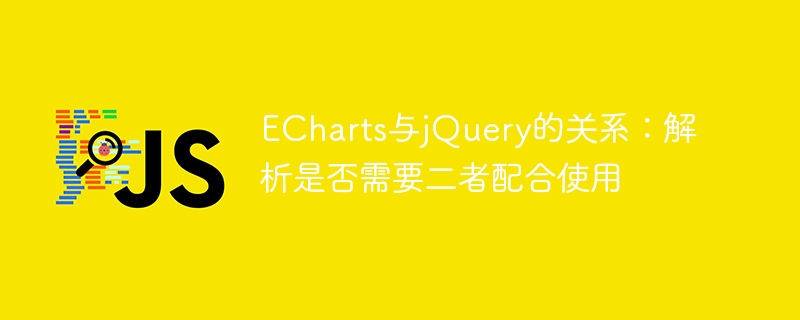

The relationship between ECharts and jQuery: To analyze whether the two need to be used together, specific code examples are required
With the widespread application of data visualization in web development, ECharts and jQuery As two common front-end libraries, jQuery is used more and more frequently in projects. As an excellent chart library, ECharts provides a variety of chart types and flexible configuration options, which can help developers quickly realize various data visualization needs. As a lightweight JavaScript library, jQuery can simplify DOM operations, event processing, Ajax requests and other operations, making front-end development more efficient.
In actual projects, developers often face a question: Do they need to use jQuery when using ECharts? This article will analyze the relationship between ECharts and jQuery, their advantages and disadvantages, whether they need to be used together, and specific code examples.
First of all, let us briefly understand the characteristics and functions of ECharts and jQuery:
ECharts is a data visualization library developed and maintained by Baidu. It is based on Canvas and SVG technology and provides Various common chart types, such as line charts, bar charts, pie charts, etc., also support dynamic updating and interaction of data, which can achieve more complex data visualization effects.
jQuery is a lightweight and efficient JavaScript library that encapsulates a series of common operations such as DOM operations, event processing, Ajax requests, etc. It can simplify the amount of code for developers and improve development efficiency.
Next, let’s analyze the usage of ECharts and jQuery in the project:
Finally, in order to further illustrate whether ECharts and jQuery need to be used together, we provide a specific code example:
<!DOCTYPE html>
<html>
<head>
<title>ECharts与jQuery的使用示例</title>
<script src="https://cdn.bootcdn.net/ajax/libs/jquery/3.6.0/jquery.min.js"></script>
<script src="https://cdn.bootcdn.net/ajax/libs/echarts/5.1.1/echarts.min.js"></script>
</head>
<body>
<div id="main" style="width: 600px;height:400px;"></div>
<script>
var myChart = echarts.init(document.getElementById('main'));
var option = {
xAxis: {
type: 'category',
data: ['Mon', 'Tue', 'Wed', 'Thu', 'Fri', 'Sat', 'Sun']
},
yAxis: {
type: 'value'
},
series: [{
data: [120, 200, 150, 80, 70, 110, 130],
type: 'bar'
}]
};
myChart.setOption(option);
</script>
</body>
</html>In the above code example, we use ECharts to show a A simple histogram is implemented by introducing the JS library of ECharts and calling the relevant API. It does not involve the use of jQuery. This shows that in some simple data visualization scenarios, there is no need to introduce additional jQuery to cooperate with the use of ECharts.
To sum up, ECharts and jQuery each have their own advantages and applicable scenarios. Whether they need to be used together depends on the specific project requirements. In actual development, you can flexibly choose whether to use jQuery to assist the use of ECharts according to the project situation to avoid unnecessary dependencies and code redundancy. We hope that the analysis in this article can help developers better understand the relationship between ECharts and jQuery and improve front-end development efficiency.
The above is the detailed content of Analyze whether ECharts can be used alone without cooperating with jQuery. For more information, please follow other related articles on the PHP Chinese website!